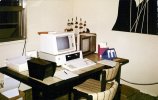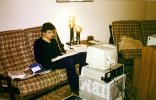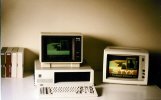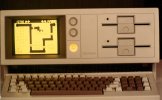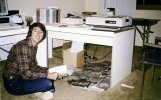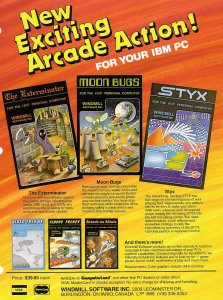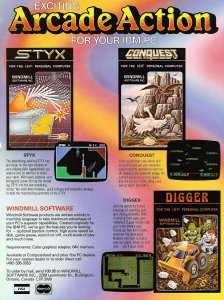|
|
|
|
|
|
|
|
|
|
|
|
|
|
|
|
|
|
|
|
|
|
|
|
|
|
|
|
|
|
|
|
|
|
|
|
|
|
|
|

Windmill software is based in Toronto, Canada and run by Jo-Anne Kempe. They no longer publish games, but now specialize in software for property management systems and custom management information systems (MIS) software. If you would like more information about Jo-Anne's company and its international capabilities in housing and building/facility management in custom MIS projects, contact her at Canada 905 639 4515 or visit the Windmill Software website.
Between 1982 and 1985, Windmill published two utility programs ("VideoGraph 88" and "VideoLink 88") and ten games - "Floppy Frenzy", "Attack on Altair", "Moonbugs", "The Exterminator", "Styx", "Digger", "Conquest", "Rollo and the Brush Brothers" and "Vortex" (a "Tempest" clone). All of the published games except "Vortex" are available from the download page.
Windmill also created two unreleased games, "PeeWee" (a Q*bert clone) and a version of asteroids.
The people behind
the games
Contrary to earlier rumours, Jo-Anne Kempe was not involved in the programming
of the Windmill games - her role was simply as an advisor in that endeavour.
Rob Sleath (the now-ex husband of Jo-Anne Kempe) was the primary developer of most of the Windmill games. He also coordinated the efforts and helped out with the other games. He was born in Leicester, England and at the age of 10 moved with his family to Burlington, Ontario in September 1966. His hobbies during the Windmill era included sailing, amateur radio, electronic design, playing piano/electric organ and listening to music, especially anything synthesized such as Kraftwerk. It was through amateur radio that Rob met the other Windmill developers, Bill Montgomery and Ray Ewan.
Bill Montgomery was one of the first `computer hackers' as he designed circuitry, PC boards and software for the original 8080 chip as it was being introduced. Rob was amazed at the things Bill was doing with the `new' single chip computers and became interested in developing his own home built system. Rob initially used Bill's board layout and other designs and later started to develop his own circuitry.
Ray Ewan was one of the youngest kids to get his amateur radio license (Rob thinks he was about 12 at the time.) Ray was interested in building a computer system similar to the one that Bill and Rob had developed and the three all kept in close contact during the early `computer hobbyist' era. Ray was also a very talented Keyboard player and seemed to excel in everything he put his mind to. Ray was probably responsible for most of the creative side, as well as some of the team's best technical achievements. He added a lot of 'fun' ideas and was the real gamer of the group. If it needed endless hours of testing then Ray was the guy.
Pre-Windmill
history - 1976 to 1982
Rob started building computer related projects in 1976. He designed, built and
programmed several home brew systems and wrote a simple tape operating system
for a surplus 9 track real-to-real tape. This was his first `mass storage'
device. He started his commercial software quest by creating several programs
for the Radio Shack Color Computer (CoCo). One of these was a battleships game
and it, along with others, was marketed by US distributor. Rob was interested
in speech synthesis so he borrowed a Votrax hardware speech synthesizer and
used it to design a software only system built around the CoCo. At this time,
the idea of a software only speech synthesizer was very new and not really
attainable. The final product was marketed along with his other CoCo games but
it didn't work very well. He got around this by creating a demo program that
asked the user to type a number on the keyboard. The program would then `say'
the number back. As the user knew what to expect, the computer `seemed' to
sound right but if you didn't know what was coming, it was hard to
understand.
Rob graduated from College as an Electronic Technologist in 1977 and worked as
an EL technician for Environment Canada from 1977 to 1981. During his time
there he maintained electronic and computer equipment and designed, built and
programmed custom equipment. Some highlights:
- Calibrated and maintained radar ranging devices, microwave distance measurement equipment, hydrographic depth sounders and radio-telephone communication equipment.
- Designed, constructed and programmed microcomputer development systems based on 8080 CP/M architecture as well as Intel, Motorola and DEC systems.
- Designed, constructed and programmed custom equipment, including the electronics required to run a robot system in the high Arctic using 8080 assembly language and a digital motor controller for a depth sounder using Z80 assembly language in a hardware environment with no RAM memory.
In 1981 he left Environment Canada to work as the head of technical services for a 3 store ComputerLand chain.
Beginning Windmill
Software - 1982
When IBM introduced the first PC, Rob bought one of the first available in
Canada. A ComputerLand customer needed a screen print routine for the IBM PC so
he elected to work on it in his spare time. The result was his first PC
product, VideoGraph 88. This was a utility that took the graphics screen and
printed it. The `PrintScreen' function in the PC only printed text at that time
and graphics was not a standard part of most printers used with the PC. The
product was sold in the local store to about 10 customers and at the suggestion
of the Store owner, Diane Reader-Jones, Rob decided to create a company and
market the product himself. Diane was one of the ComputerLand product review
committee members that determined which products the entire chain of CL stores
would carry and with her help, VG88 was the first 3rd party software product
carried by ComputerLand chain.
With the success of the VG88 product, Rob started developing a communications program in Basic that would be called VideoLink 88. The `Video' part of the name came from the first product and the `Link' referred to communications. The `88' in most of the product names came from his `lucky number', `8'.
Up until this time, the software development was an `on the side' hobby. He decided to take a big risk and quit working full time to develop software. He worked 2 days a week for CL and developed software in almost every other waking minute. After a few months, he left CL altogether and became a `full time' software developer.
Realizing the game potential, he teamed up Ray Ewan. Ray also shared his computer hardware/software and electronic music interests. The `Joan Drive' address on the early product literature was Ray's address as Rob lived in an apartment at the time and intended to move.
Rob continued to produce VideoTrek 88 - A real time `Star Trek' game written in Basic. Here we go again with the strange name. It was getting boring but at least all the products were consistent. That was a trend with several of the bigger companies of the era.
Ray developed Floppy Frenzy in interpreted Basic and it would be released as soon as a compiled basic was available. Rob worked a little on FF but most of the product and the ideas were Ray's. Ray finally convinced Rob to get rid of the `VideoX 88' naming scheme and use names with a little more appeal.
With the success of Floppy Frenzy, Bill Montgomery joined the Windmill development team. Bill liked to work on more operating system components and was the designer of the multi task core logic, run length encoding, disk I/O and many other utilities that are hidden within the development libraries. They all decided that they wanted to take the plunge and develop sound, graphic and support libraries in `C' and assembler. The advent of the `Lattice C' compiler allowed them great freedom compared to the limitations of Basic. All code used was developed by the team as little or no third party libraries existed at that time.
Windmill in
1983
Ray developed the low res 16 color graphics library that would be used in the
next few games. They wanted to have more colors than the standard 4 color
palette and a comment in the IBM Tech manual (their Bible) pointed to an almost
undocumented mode. This gave them a jump up on other companies that used the
standard mode. To the best of Rob's knowledge, no other companies had used the
16 color mode to date.
Rob developed the beginnings of a sound library. It would get a major overhaul after the first group of games was completed.
Bill developed Attack on Altair, Ray created Moon Bugs and Rob worked on The Exterminator. After Exterminator, Rob started Styx but ran into difficulties and the program was shelved.
Ray decided that they needed a better graphics system and developed their `sprite' graphics engine. This was a fairly new concept at the time and made advanced object manipulation fairly easy within the actual game code.
Rob modified the sound system to use pulse width modulation of the one bit speaker. The speaker was either on or off but by varying the width of the pulse, the volume could be varied and harmonic content created. This gave a volume envelope to the sound rather than just `beeps'. Rob believes this was the first time this technique had been used in the PC environment, and still sees the sound system as his greatest achievement in the PC environment.
Rob went on to create Digger and finish Styx while Ray worked on the graphics library. Rob then moved on to Conquest and Ray started developing PeeWee.
Windmill in
1984
The last PC game that Rob produced was Rollo and the Brush Brothers. Around
this time, the cost of advertising was getting higher. The cost of producing
and marketing a new product was approaching the expected sales income so games
in the North American market were becoming much less profitable. When PeeWee
was finally ready for market, the costs were too high so it was never
released.
IBM was pushing the PC Jr for the home market and steering the Desktop PC toward the business market. Windmill decided that the PC Jr would be the next game platform and Rob started converting the current game they had already written for the PC Jr.
In March of 1984, Rob received a request from Keith Ryder of IBM Japan for evaluation copies of all of their products. Lots of people asked for free copies on company letterhead so Rob promptly ignored the request. He received a follow up phone call from Keith asking for evaluation copies. Rob told him he was welcome to them if he paid the list price by credit card. He agreed and Rob shipped the products. He still didn't believe it was the company IBM that wanted them but just an individual.
Within a couple of months, Rob was contacted by IBM with an offer to allow them to port their products to a secret new product that would be similar to the PC Jr. IBM would market Japanese and English versions of the programs in Asia and around the world. IBM Japan sent 2 complete IBM JX computer systems along with Keith as an escort so that the products could be modified and tested. The games were marketed World Wide by IBM World Trade.
Windmill in
1985
The last game that Rob produced was Vortex. This was a PC Jr and PC Jx only
product. It was never released for the PC.
Windmill in 1986 -
present
Rob moved away from games and started producing custom products for various
ComputerLand customers and other local businesses. The first custom projects
used dBase III but Rob quickly moved to Clipper (compiled dBase) for the rest
of the custom projects. Some of the more notable projects were for the Canadian
International Development Agency. These projects monitored the effectiveness of
Canadian foreign aid in Barbados, Zimbabwe and Kenya. The projects were
designed in Canada, but Rob also needed to install and modify the software in
the destination countries. Seeing Africa was a real highlight of those ventures
and numerous visits to Barbados always seemed to come in the winter, what a
coincidence!
Another product was developed for a local Housing Co-operative. The property management software went through several updates and was eventually mass marketed in Ontario.
In 1994, divorce proceedings separated the ongoing products from the Windmill name and the property management software. Jo-Anne Kempe continued to market and develop the PM software and bought out the rights to the Windmill name. Rob continued to support individual clients and work as a software consultant.
Rob is currently a computer consultant working primarily in Powerbuilder, Java using JBuilder (J2EE stuff) and web page development using Macromedia.
Rumours and
facts
Over the years, certain untrue rumours have been spread about Windmill
Software. Here we put these to rights.
Rumour: Digger was initially demoed to an audience at a gaming show in the
early 80s. The folk who created "Dig-Dug" stole the concept of Digger and beat
Windmill to the gaming market.
Fact: Digger was based on and inspired by Dig-Dug. It was never demoed at any
gaming show and was not stolen.
Rumour: Ray was the nephew of Jo-Anne Kempe
Fact: Ray was not related to Jo-Anne Kempe, and if Jo-Anne Kempe had a nephew
he was not involved with the Windmill games at all.
Rumour: Jo-Anne and Rob had two dogs, Chip and Byte, who were always laying on
the disks before they were packaged so pretty much each copy of the games had
dog hair in it.
Fact: The hair was from their first dog, Byte. Chippy was aquired much, much
later.
Rumour: Jo-Anne and Rob had "HOBBIN" and "NOBBIN" vanity plates on their
cars.
Fact: There were no "HOBBIN" and "NOBBIN" vanity plates. Rob had a personalized
l;icense plate with JX on it due to the deal with IBM for providing software
for the JX machine. This deal paid for a new BMW amongst other things.
Rumour: Windmill software had something to do with the game "J-bird".
Fact: J-bird had nothing to do with Windmill software, though both it and Ray
Ewan's game "PeeWee" were both based on Q*Bert. J-bird was released before
PeeWee was finished but PeeWee was not based on J-bird.
IBM box covers for the JX version:

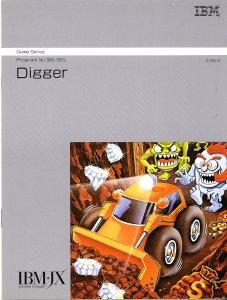
Other tidbits and
tales
Rob Sleath got in touch with me after seeing a show on TechTV which was
discussing old computer games and Home of the Underdogs. Rob though he saw a
screen from Digger, and was shocked! He searched the web and came across this
site. He has on many occasions thought of reviving the 'dead' programs but
never got much further.
Rob write VideoGraph 88 by hand in assembly language. The prototype (first about 10 copies) was written PRE IBM assembler with pencil and paper - that meant calculating jumps by hand and leaving lots of gaps for NOPs. This wasn't a big deal as he started on a home brew 8080 front panel machine (designed by Bill Montgomery) 'toggling' in the bytes. Later (when it was available) Rob used the IBM assembler for the low-level parts of the games.
Rob and Bill developed 256 byte machines together. I am typing this on a machine which has more than 6 million times as much RAM.
Rob was (and still is) a big fan of Star Trek (hence VideoTrek 88).
During development of each product, Rob, Bill Ray seemed to encounter a major bug that almost destroyed any chance of finishing the product and almost destroyed the company. In VL, a bug in the BASIC interpreter caused the program to die. They had to wait for an update before it finally worked. Several 'C' compiler bugs also caused major problems. In Conquest, the game was almost ready to ship when they found it crashed. Rob eventually ripped almost all the code out until he found the problem. The flying dino scream was killing the program. He lost about 3 weeks of sleep resolving that one.
Styx was shelved more than once as it just "couldn't be done". The 'fill' routine was a real challenge to get it to work and still be fast. The sound effects in Styx were initially there to 'fool' the user into ignoring how slow the fill was.
Rob and Jo-Anne's divorce was not an amicable one.
Jo-Anne Kempe was a sales person at ComputerLand during the Windmill games era.
Bill Montgomery is also amazed at the continuing interest in these old games. He has retired from Environment Canada and now designs model aircraft and pens. Bill and Rob have kept in touch over the years, and they both fly model helicopters at the local flying field.
Rob is also still in touch with Ray, who is now working as a software developer in New York ity. He is also persuing photography as a serious hobby these days. Ray enjoys riding his motorcycle and doing photojournalism expeditions. Apparently Ray has known about this site for a while but thought it was good to have a little mystery around the events of that era!
Coincidence: A longtime friend of Rob's has a son who works in the same building as me.
Rob has about 100 5,25" disks of code and data from that era. Fortunately the disks were still readable and the hardware to read them still worked! When he added up the size of all the files, it came to only about 16Mb!
The reason that gold disappears quickly when you dig underneath it is that the developers felt that broken bags should not fall, but they shouldn't hang in mid-air either.
The games market moved extremely fast in the early 80s and the Windmill developers didn't have any 'spare' time. They had to get things out the door as fast as possible so if it seemed to work, it was time to ship. They had several major bugs that were show stoppers so minor things were easily overlooked.
Rob was never that good at the games. He did some of the testing but mainly left that to friends and other local enthusiasts. He enjoyed the development process more than actually playing the games.
In the original source code for Digger there is a commented out data section for "tico-tico" music. This was an early attempt at recreating the Popcorn song from memory. Later Rob found the original music and modified it to make it sound more "arcade-like".
The most recent version of the original Digger source code contains some modifications to make it work with a Canadian computer called the Hyperion, which ran at 6MHz rather than 4.77MHz. That machine never sold well.
At the peak of the era, advertising was costing about $20,000 per month so they must have been selling at least 1,000 per month to break even. The sales figures were more like a bell curve with the 1,000 per month being the peak sales. That would have been for a short time as sales declined rapidly. Rob worked 18 hour days for about 2 years but didn't make much more than he would have at a well paying "regular" job. There was lots of income from sales but the expenses were high toward the end. It wasn't a big money era but it sure was exciting!
The games evolved as they were developed. The Emeralds in Digger were originally coins. In the source code there are references to the monsters as "bugs" and Digger himself as the "man". "Mr. Digger" is also mentioned in some of the comments. I guess that puts any speculation as to the gender of Digger to rest!
The text editor used to write all the source code for the games was PMATE. Bill and Rob had used lots of other editors including DEC derivatives but PMATE was so much better than anything else of the day.
Digger was developed on a machine with two 5.25" floppy drives and no hard drive. As was common in those days, some of the system memory was set aside as a "RAM Drive" to store commonly used files.
Early in its development, "The Exterminator" was called "Ant Attack".
All the manufacturing for the Windmill games was done at home. Rob even had a shrink wrap machine set up in the basement. It was was very smelly when it was running so they had to have all the basement windows open to clear the air.
After Qix (which was the inspiration for Styx), Rob's favourite arcade game was "Tempest" (which was the inspiration for Vortex).
Bill Montgomery was a big Bob Dylan fan when Rob met him. He introduced Rob to Dylan as well as computers. All Rob's early software and the games were written with Dylan music to code by.
Older
articles
These contain some inaccuracies. Where the information in these articles
conflicts with the information on this page, the information on this page
should be considered definitive.
An email from an a contributor who wishes to remain anonymous.

